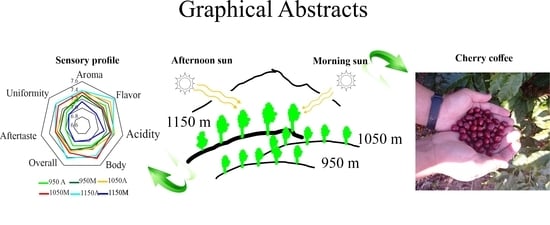Association of Altitude and Solar Radiation to Understand Coffee Quality
Abstract
1. Introduction
2. Materials and Methods
2.1. Geographical Description of the Area and Cultivar of Arabica Coffee under Study
2.2. Climatic Characteristics and Cultural Treatments of Coffee
2.3. Harvest and Post-Harvest of Coffee Cherries
2.4. Physical Analysis of Coffee Beans
2.5. Sensory Analysis of Coffee Beans
2.6. Statistical Analysis
3. Results
4. Discussion
5. Conclusions
Supplementary Materials
Author Contributions
Funding
Data Availability Statement
Acknowledgments
Conflicts of Interest
References
- ICO. Organização Internacional Do Café, Revista Eletrônica Situada. Available online: http://www.ico.org/pt/about_statistics_p.asp?section=Estat%EDstica (accessed on 25 March 2021).
- Sobreira, F.M.; Oliveira, A.C.B.; Pereira, A.A.; Gonçalves, M.A.; Sakiiyama, N.S. Divergence among Arabica coffee genotypes for sensory quality. Aust. J. Crop. Sci. 2016, 10, 1442–1448. [Google Scholar] [CrossRef]
- Barbosa, I.P.; Oliveira, A.C.B.; Rosado, R.D.S.; Sakyama, N.S.; Cruz, C.D.; Pereira, A.A. Sensory quality of Coffea arabica L. genotypes influenced by postharvest processing. Crop. Breed. Appl. Biotechnol. 2019, 19, 428. [Google Scholar] [CrossRef]
- Barbosa, I.P.; De Oliveira, A.C.B.; Rosado, R.D.S.; Sakiyama, N.S.; Cruz, C.D.; Pereira, A.A. Sensory analysis of Arabica coffee: Cultivars of rust resistance with potential for the specialty coffee market. Euphytica 2020, 216, 165. [Google Scholar] [CrossRef]
- Ferreira, D.S.; Bravin, G.C.; Nascimento, M.; Nascimento, A.C.C.; Ferreira, J.M.S.; Amaral, J.F.T.; Pereira, L.L.; Rodrigues, W.N.; Ribeiro, W.R.; Castanheira, D.T.; et al. Exploring the multivariate technique in the discrimination of Coffea arabica L. cultivars regarding the production and quality of grains under the effect of water management. Euphytica 2021, 217, 118. [Google Scholar] [CrossRef]
- Zaidan, U.R.; Corrêa, P.C.; Ferreira, W.P.M.; Cecon, P.R. Environment and varieties influence the quality of coffees in Matas de Minas. Coffee Sci. 2017, 12, 240–247. [Google Scholar] [CrossRef][Green Version]
- Pereira, L.L.; Guarçoni, R.C.; Cardoso, W.S.; Taques, R.C.; Moreira, T.R.; Da Silva, S.F.; Caten, C.S.T. Influence of Solar Radiation and Wet Processing on the Final Quality of Arabica Coffee. J. Food Qual. 2018, 2018, 1–9. [Google Scholar] [CrossRef]
- Borém, F.M.; Cirillo, M.A.; Alves, A.P.C.; Santos, C.M.; Liska, G.R.; Ramos, M.F.; Lima, R.R. Coffee sensory quality study based on spatial distribution in the Mantiqueira mountain region of Brazil. J. Sens. Stud. 2019, 35, 12552. [Google Scholar] [CrossRef]
- Veloso, T.G.R.; da Silva, M.C.S.; Cardoso, W.S.; Guarçoni, R.C.; Kasuya, M.C.M.; Pereira, L.L. Efeitos de fatores ambientais na microbiota de frutos e solo de Coffea arabica no Brasil. Sci. Rep. 2020, 10, 14692. [Google Scholar] [CrossRef]
- Debona, D.G.; Pinheiro, P.F.; Pinheiro, C.A.; Gomes, W.S.; Abreu, R.O.; Moreli, A.P.; Siqueira, E.A.; Pereira, L.L. Avaliação da composição química de café arábica submetido a diferentes perfis de torra. Rev. IFES Ciência 2020, 6, 124–133. [Google Scholar] [CrossRef]
- Agnoletti, B.Z.; Pinheiro, P.F.; Pereira, L.L.; Oliveira, E.C.S.; Filgueiras, P.R. Discriminação de café arábica quanto à qualidade sensorial utilizando cromatografia gasosa e PLS-DA. Rev. IFES Ciência 2020, 6, 147–158. [Google Scholar] [CrossRef]
- Ferreira, D.S.; Do Amaral, J.F.T.; Pereira, L.L.; Ferreira, J.M.S.; Guaçoni, R.C.; Moreira, T.R.; De Oliveira, A.C.; Rodrigues, W.N.; De Almeida, S.L.H.; Ribeiro, W.R.; et al. Physico-chemical and sensory interactions of Arabica coffee genotypes in different water regimes. J. Agric. Sci. 2021, 159, 1–9. [Google Scholar] [CrossRef]
- Joët, T.; Salmona, J.; Laffargue, A.; Descroix, F.; Dussert, S. Use of the growing environment asa source of variation to identify the quantitative trait transcriptsand modules of co-expressed genes that determine chlorogenic acid accumulation. Plant Cell Environ. 2010, 33, 1220–1233. [Google Scholar] [PubMed]
- Ferreira, W.P.M.; Queiroz, D.M.; Silvac, S.A.; Tomaz, R.S.; Corrêa, P.C. Effects of the orientation of the mountainside, altitude and varieties on the quality of the coffee beverage from the “Matas de Minas” Region, Brazilian Southeast Retrieved from. Am. J. Plant Sci. 2016, 7, 1291–1303. [Google Scholar] [CrossRef][Green Version]
- Scholz, M.B.S.; Kitzberger, C.S.G.; Prudencio, S.H.; Silva, R.S.S.F. The typicity of coffees from different terroirs determined by groups of T physico-chemical and sensory variables and multiple factor analysis. Food Res. Int. 2018, 114, 72–80. [Google Scholar] [CrossRef] [PubMed]
- Guyot, B.; Gueule, D.; Manez, J.C.; Perriot, J.J.; Giron, J.; Villain, L. Influence de laltitude et de l’ombrage sur la qualité des cafés Arabica. Juillet Août Plant Rech. Développement 1996, 3, 272–283. [Google Scholar]
- Bosselmann, A.S.; Dons, K.; Oberthur, T.; Olsen, C.S.; Ræbild, A.; Usma, H. He influence of shade trees on coffee quality in small holder coffee agroforestry systems in Southern Colombia. Agric. Ecosyst. Environ. 2009, 129, 253–260. [Google Scholar] [CrossRef]
- Bertrand, B.; Vaast, P.; Alpizar, E.; Etienne, H.; Davrieux, F.; Charmetant, P. Comparação da composição bioquímica do feijão e da qualidade da bebida de híbridos de Arábica envolvendo origens sudanesas-etíopes com variedades tradicionais em várias elevações na América Central. Tree Physiol. 2006, 26, 1239–1248. [Google Scholar] [CrossRef]
- De Bruyn, F.; Zhang, S.J.; Pothokos, V.; Torres, J.; Lombot, C.; Moroni, A.V.; Callanan, M.; Sybesma, W.; Weckx, S.; De Vusty, L. Exploring the Impacts of Postharvest Processing on the Microbiota and Metabolite Profiles during Green Coffee Bean Production. Appl. Environ. Microbiol. 2016, 83, 1–40. [Google Scholar] [CrossRef]
- Pereira, L.L.; Guarçoni, R.C.; Pinheiro, P.F.; Osório, V.M.; Pinheiro, C.A.; Moreira, T.R.; Caten, C.S.T. New propositions about coffee wet processing: Chemical and sensory perspectives. Food Chem. 2020, 310, 125943. [Google Scholar] [CrossRef]
- Iamanaka, B.T.; Teixeira, A.A.; Teixeira, A.R.R.; Copetti, M.V.; Bragagnolo, N.; Taniwaki, M.H. Reprint of “The mycobiota of coffee beans and its influence on the coffee beverage”. Food Res. Int. 2014, 61, 33–38. [Google Scholar] [CrossRef]
- Sakiyama, N.S.; Martinez, H.E.P.; Tomaz, M.A.; Borém, A. Café Arábica, do Plantio a Colheita; Editora UFV: Abbotsford, BC, Canada, 2015; 316p. [Google Scholar]
- Martinez, H.E.P.; Neves, J.C.L. Nutrição mineral, calagem, gessagem e adubação. In Café arábica, do plantio a colheita; Sakiyama, N.S., Martinez, H.E.P., Tomaz, M.A., Borém, A., Eds.; Editora UFV: Abbotsford, BC, Canada, 2015; 316p. [Google Scholar]
- Ministério de Estado da Agricultura, Pecuária e Abastecimento. Dispõe de regulamento técnico de identidade e de qualidade para a classificação do café beneficiado grão cru. In Instrução Normativa n° 8 de 11 de julho de 2003; Ministério de Estado da Agricultura, Pecuária e Abastecimento: Brasília, Brazil, 2003; 12p. [Google Scholar]
- Pereira, L.L.; Guarçoni, R.; Souza, G.S.; Brioschi Junior, D.; Moreira, T.R.; Caten, C.T.S. Propositions on the optimal number of Q-gradersand R-graders. J. Food Qual. 2018, 2018, 1–7. [Google Scholar] [CrossRef]
- SCAA-Specialty Coffee Association Of American. Protocols 23. 2013. Available online: http://www.scaa.org/PDF/resources/cupping-protocols.pdf (accessed on 15 April 2021).
- Ferreira, D.F. Multivariate Statistics, 3rd ed.; Editora UFLA: Lavras, Brazil, 2018; 642p. [Google Scholar]
- R Core Team. R: A Language and Environment for Statistical Computing. R Foundation for Statistical Computing, Vienna. 2022. Available online: https://www.R-project.org (accessed on 10 January 2022).
- Da Matta, F.M. Exploring drought tolerance in coffee: A physiological approach with some insights for plant breeding. Braz. J. Plant Physiol. 2004, 16, 1–6. [Google Scholar] [CrossRef]
- Fagan, E.B.; Souza, C.H.E.; Pereira, N.M.B.; Machado, V.J. Effect of coffee bean formation time (Coffea sp.) on beverage quality. Biosci. J. 2011, 27, 729–738. [Google Scholar]
- Evangelhista, S.R.; Silva, C.F.; Miguel, M.G.P.C.; Cordeiro, C.S.C.; Pinheiro, A.C.M.; Duarte, W.F.; Schwan, R.F. Improvement of coffee beverage quality by using selected yeasts strains during the fermentation in dry process. Food Res. Int. 2014, 61, 183–195. [Google Scholar] [CrossRef]
- Setotaw, T.A.; Caixeta, E.T.; Pereira, A.A.; Oliveira, A.C.B.; Cruz, C.D.; Zambolim, E.M.; Zambolim, L.; Sakiyama, N.S. Coeficiente de parentesco em cultivares de Coffea arabica L. cultivadas no Brasil. Crop. Sci. 2013, 53, 1237–1247. [Google Scholar] [CrossRef]
- Vaast, P.; Bertrand, B.; Perriot, J.J.; Guyot, B.; Gérnad, M. Fruit thinning and shade improve bean characteristicsand beverage quality of coffee (Coffea arabica L.) under optimal conditions. J. Sci. Food Agric. 2006, 86, 197–204. [Google Scholar] [CrossRef]
- Geromel, C.; Ferreira, L.P.; Davrieux, F.; Guyot, B.; Ribeyre, F.; Scholz, M.B.S.; Pereira, L.F.P.; Vasst, P.; Pot, D.; Leroy, T.; et al. Effects of shade on the development and sugar metabolism of coffee (Coffea arabica L.) fruits. Plant Physiol. Biochem. 2008, 46, 569–579. [Google Scholar] [CrossRef]
- Oliveira, M.N.V.; Santos, T.M.A.; Vale, H.M.M.; Delvaux, J.C.; Cordeiro, A.P.; Ferreira, A.B.; Miguel, P.S.B.; Tótola, M.R.; Costa, M.D.; Moraes, C.A.; et al. Endophytic microbial diversity in coffee cherries of Coffea arabica from southeastern Brazil. Can. J. Microbiol. 2013, 59, 221–230. [Google Scholar] [CrossRef]
- Kurungi, J.; Cherukut, S.; Ijala, A.R.; Tumuhaiwe, J.B.; Bonabana-Wabbi, J.; Nuppenau, E.A.; Hoeher, M.; Domptail, S.; Otte, A. Elevation and cropping system as drivers of microclimate and abundance of soil macrofauna in coffee farmlands in mountainous ecologies. Appl. Soil Ecol. 2018, 132, 126–134. [Google Scholar] [CrossRef]
- Pretes Júnior, P.; Moreira, B.C.M.; Silva, M.M.C.; Veloso, T.G.R.; Stürmer, S.L.; Fernandes, R.B.A.; Mendonça, E.S.; Kasuya, M.C.M. Agroecological cofee management increases arbuscular mycorrhizal fungi diversity. PLoS ONE 2019, 14, e0209093. [Google Scholar]
- Bressani, A.P.P.; Martinez, S.J.; Evangelista, S.R.; Diasa, D.R.; Schwan, R.F. Characteristics of fermented coffee inoculated with yeast starter cultures using different inoculation methods. Food Sci. Technol. 2018, 92, 212–219. [Google Scholar] [CrossRef]
- Liebig, T.; Ribeyre, F.; Läderach, P.; Poehling, H.M.; Asten, P.V.; Avelino, J. Interactive effects of altitude, microclimate and shading system on coffee leaf rust. J. Plant Interact. 2019, 14, 407–415. [Google Scholar] [CrossRef]
- Gomes, L.C.; Bianchi, F.J.J.A.; Cardoso, I.M.; Fernandes, R.B.A.; Fernandes Filho, E.I.; Schulte, R.P.O. Agroforestry systems can mitigate the impacts of climate change on coffee production: A spatially explicit assessment in Brazil. Agric. Ecosyst. Environ. 2020, 294, 106858. [Google Scholar] [CrossRef]
- Lu, Y.; Zhang, M.; Meng, X.; Wan, H.; Zhang, J.; Tian, J.; Yao, Y. Photoperiod and shading regulate coloration and anthocyanin accumulation in the leaves of malus crabapples. Plant Cell Tissue Organ. Cult. 2015, 121, 619–632. [Google Scholar] [CrossRef]
- DaMatta, F.M.; Avila, R.T.; Cardoso, A.A.; Martins, S.C.; Ramalho, J.C. Physiological and agronomic performance of the coffee crop in the context of climate change and global warming: A review. J. Agric. Food Chem. 2018, 66, 5264–5274. [Google Scholar] [CrossRef] [PubMed]
- Slot, M.; Krause, G.H.; Krause, B.; Hernández, G.G.; Winter, K. Photosynthetic heat tolerance of shade and sun leaves of three tropical tree species. Photosynth. Res. 2019, 141, 119–130. [Google Scholar] [CrossRef]
- Ferreira, D.S.; Sales, R.A.; Amaral, J.F.T.; Ferreira, J.M.S.; Venancio, L.P.; Ribeiro, W.R.; Tomaz, M.A.; Catem, D.S.B.; Gonçalves, M.S.; Bravin, N.P. Biochemical and physiological changes in conilon coffee (Coffea canephora) grown under different levels of irradiance. Aust. J. Crop Sci. 2021, 15, 1071–1080. [Google Scholar] [CrossRef]
- Pereira, L.L. Novas Abordagens Para Produção de Cafés Especiais a Partir do Processamento Via-Úmida. 2017, 200f. Tese de doutorado, Universidade Federal do Rio Grande do Sul, Rio Grande do Sul, Brazil, 2017. [Google Scholar]
- Siqueira, H.H.; Abreu, C.M.P. Physico-chemical composition and quality of coffee submitted to two types of roasting and with different forms of processing. Ciência E Agrotecnologia 2006, 30, 112–117. [Google Scholar] [CrossRef]
- Ribeiro, B.B.; Nunes, C.A.; Souza, A.J.J.; Montanari, F.F.; Silva, V.A.; Madeira, R.A.V.; Piza, C. Perfil sensorial de cultivares de café processados por via seca e via úmida após o armazenamento. Coffee Sci. 2017, 12, 48–155. [Google Scholar] [CrossRef][Green Version]
- Pereira, L.L.; Moreli, A.P.; Brioschi, D.; Guarconi, R.C. Fermentação do Café e Pós Colheita, 1st ed.; Ad Verbum: Herval d’Oeste, Brazil, 2019; Volume 1, 24p. [Google Scholar]
- Pereira, L.L.; Moreira, T.R. Quality Determinants In Coffee Production, 1st ed.; Springer Nature: New York, NY, USA, 2021; Volume 1, 709p. [Google Scholar]
- Martinez, S.J.; Rabelo, M.H.S.; Bressani, A.P.P.; Motta, M.C.B.; Borém, F.M.; Schawan, R.F. Novel stainless steel tanks enhances coffee fermentation quality. Food Res. Int. 2021, 13, 109921. [Google Scholar] [CrossRef]
- Jesus Junior, W.C.; Martins, L.D.; Rodrigues, W.N.; Moraes, W.B.; Amaral, J.F.T.; Tomaz, M.A.; Alves, F.R. Mudanças climáticas: Potencial impacto na sustentabilidade da cafeicultura. In Rodrigues WN (Org.) Inovação, Difusão e Integração: Bases para a Sustentabilidade da Cafeicultura, 1st ed.; Tomaz, M.A., Amaral, J.F.T., Jesus Junior, W.C., Fonseca, A.F.A., Ferrão, R.G., Ferrão, M.A.G., Martins, L.D., Eds.; CAUFES: Alegre, Brazil, 2012; Volume 1, pp. 179–201. [Google Scholar]
- Borém, F.M.; Coradi, P.C.; Saath, R.; Oliveira, J.A. Quality of natural and washed coffee after drying on ground and with high temperature. Ciência E Agrotecnologia 2008, 32, 1609–1615. [Google Scholar] [CrossRef]
- Alves, A.L.; Pessoa, M.S.; Souza, P.E.N.; Partelli, F.L.; Mascon, P.S.; Silva, E.C.; Guimarães, A.O.; Muniz, E.P.; Pinheiro, P.F.; Borém, F.M.; et al. Influence of environmental and microclimate factors on the coffee beans quality (Coffea canephora): Correlation between chemical analysisand stable free radicals. Agric. Sci. 2018, 9, 1173–1187. [Google Scholar]
- Matiello, J.B.; Santinato, R.; Garcia, A.W.R.; Almeida, S.R.; Fernandes, D.R. Cultura de Café no Brasil—Manual de Recomendações, 2nd ed.; Fundação Procafé: Rio de Janeiro, Brazil, 2020; 716p. [Google Scholar]
- CONAB—Companhia Nacional de Abastecimento. Acompanhamento de Safra Brasileira de Café, Primeiro Levantamento/Janeiro 2019; CONAB—Companhia Nacional de Abastecimento: Brasília, Brazil, 2019; pp. 1–77.
- Pimenta, C.J.; Chagas, S.J.R.; Costa, L. Polifenoloxidase, lixiviação de potássio e qualidade de bebida do café colhido em quatro estádios de maturação. Pesqui. Agropecuária Bras. 1997, 32, 171–177. [Google Scholar]
- Camargo, A.P.; Camargo, M.B.P. Definição e esquematização das fases fenológicas do cafeeiro Arábica nas condições tropicais do Brasil. Bragantia 2001, 60, 65–68. [Google Scholar] [CrossRef]
- DaMatta, F.M.; Ronchi, C.P.; Maestri, M.; Barros, R.S. Ecophysiology of coffee growth and production. Braz. J. Plant Physiol. 2007, 19, 485–510. [Google Scholar] [CrossRef]
- Meireles, E.J.L.; Camargo, M.B.P.; Pezzopane, J.R.M.; Thomaziello, R.A.; Fahi, J.I.; Bardin, L.; Santos, J.C.F.; Japiassú, L.B.; Garcia, A.W.R.; Miguel, A.E.; et al. Fenologia do Cafeeiro: Condições Agrometeorológicas e Balanço Hídrico do Ano Agrícola 2004–2005; Embrapa Informação Tecnológica: Brasília, Brazil, 2009. [Google Scholar]
- Marsetti, M.M.S.; Bonomo, R.; Partelli, F.L.; Saraiva, G.S. Déficit hídrico e fatores climáticos na uniformidade da florada do cafeeiro Conilon irrigado. Rev. Bras. De Agric. Irrig. 2013, 7, 371–380. [Google Scholar] [CrossRef]

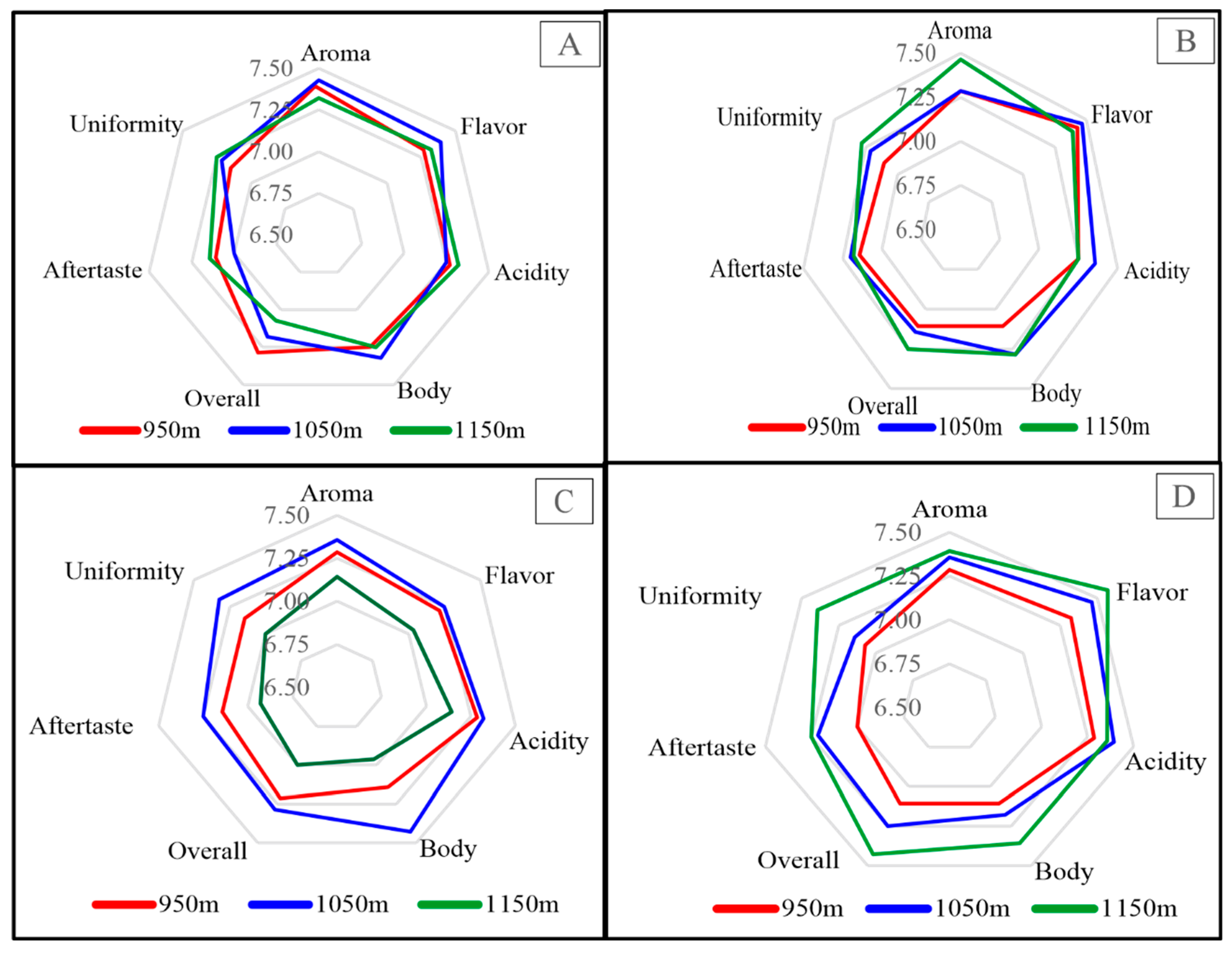
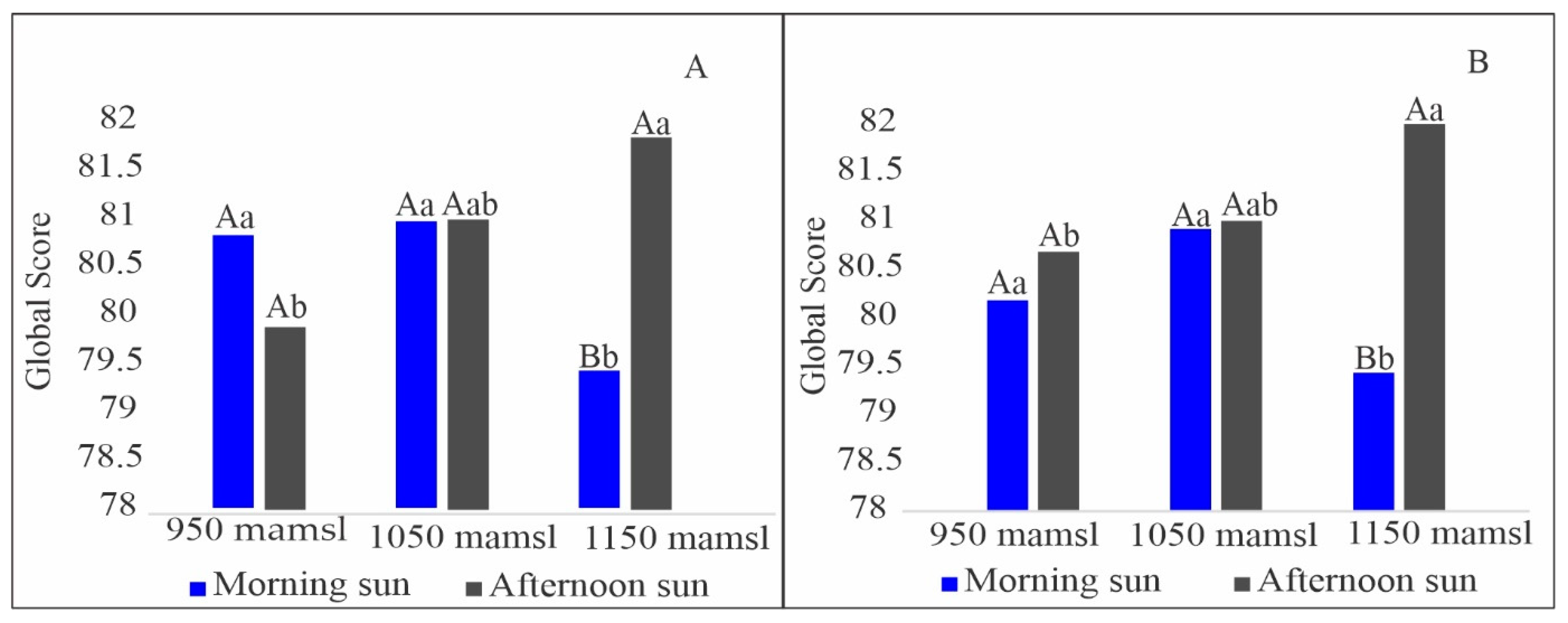
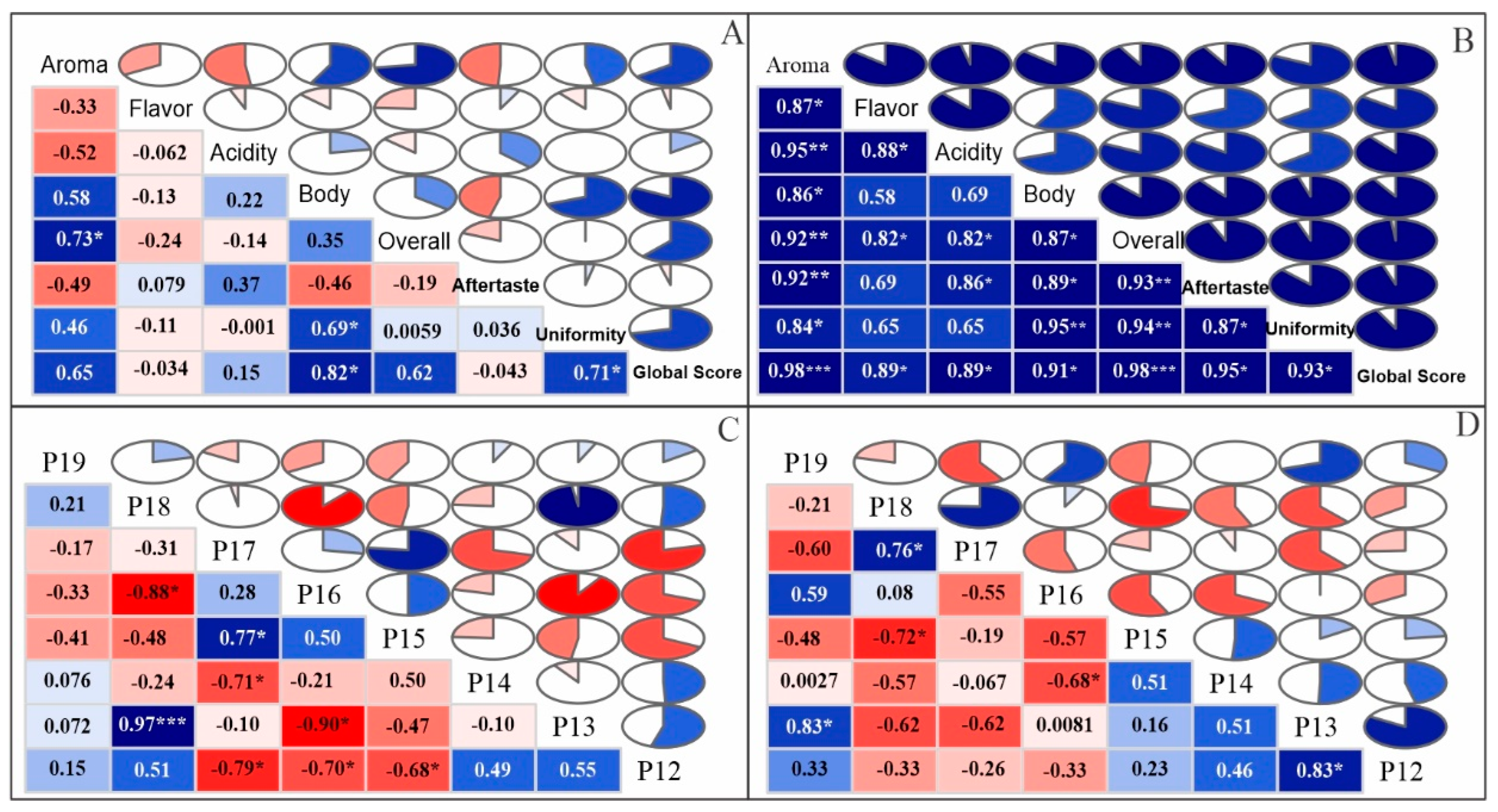
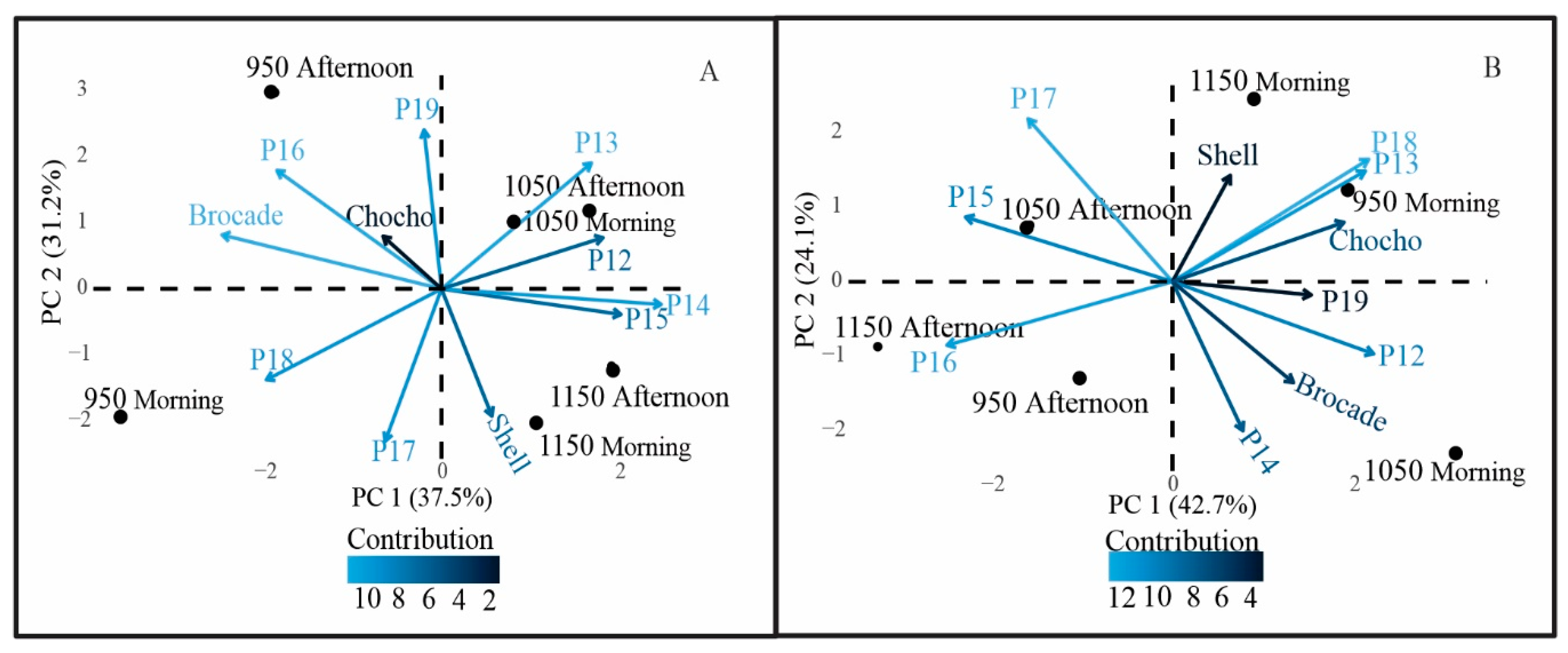
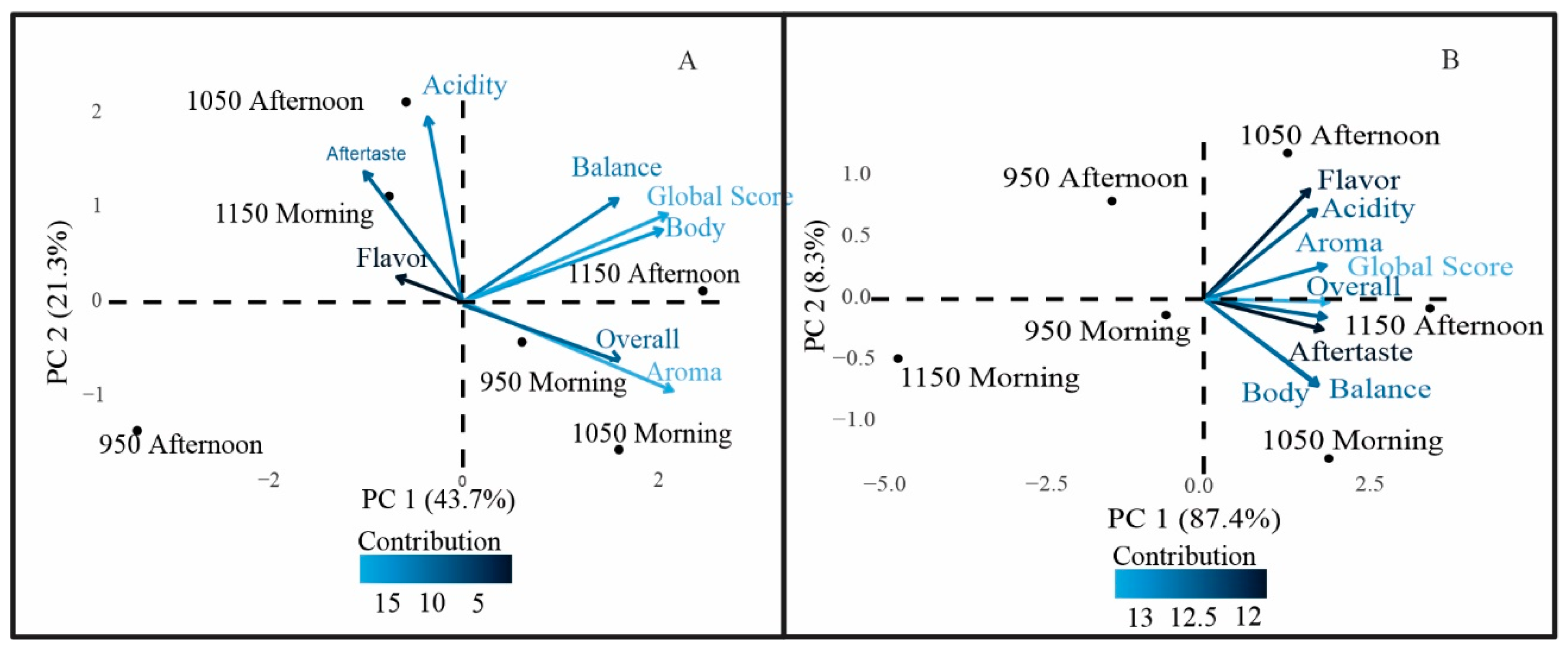
Publisher’s Note: MDPI stays neutral with regard to jurisdictional claims in published maps and institutional affiliations. |
© 2022 by the authors. Licensee MDPI, Basel, Switzerland. This article is an open access article distributed under the terms and conditions of the Creative Commons Attribution (CC BY) license (https://creativecommons.org/licenses/by/4.0/).
Share and Cite
Soares Ferreira, D.; Eduardo da Silva Oliveira, M.; Rodrigues Ribeiro, W.; Altoé Filete, C.; Toledo Castanheira, D.; Cesar Pereira Rocha, B.; Polonini Moreli, A.; Catarina da Silva Oliveira, E.; Carvalho Guarçoni, R.; Partelli, F.L.; et al. Association of Altitude and Solar Radiation to Understand Coffee Quality. Agronomy 2022, 12, 1885. https://doi.org/10.3390/agronomy12081885
Soares Ferreira D, Eduardo da Silva Oliveira M, Rodrigues Ribeiro W, Altoé Filete C, Toledo Castanheira D, Cesar Pereira Rocha B, Polonini Moreli A, Catarina da Silva Oliveira E, Carvalho Guarçoni R, Partelli FL, et al. Association of Altitude and Solar Radiation to Understand Coffee Quality. Agronomy. 2022; 12(8):1885. https://doi.org/10.3390/agronomy12081885
Chicago/Turabian StyleSoares Ferreira, Daniel, Matheus Eduardo da Silva Oliveira, Wilian Rodrigues Ribeiro, Cristhiane Altoé Filete, Dalyse Toledo Castanheira, Brunno Cesar Pereira Rocha, Aldemar Polonini Moreli, Emanuele Catarina da Silva Oliveira, Rogério Carvalho Guarçoni, Fábio Luiz Partelli, and et al. 2022. "Association of Altitude and Solar Radiation to Understand Coffee Quality" Agronomy 12, no. 8: 1885. https://doi.org/10.3390/agronomy12081885
APA StyleSoares Ferreira, D., Eduardo da Silva Oliveira, M., Rodrigues Ribeiro, W., Altoé Filete, C., Toledo Castanheira, D., Cesar Pereira Rocha, B., Polonini Moreli, A., Catarina da Silva Oliveira, E., Carvalho Guarçoni, R., Partelli, F. L., & Louzada Pereira, L. (2022). Association of Altitude and Solar Radiation to Understand Coffee Quality. Agronomy, 12(8), 1885. https://doi.org/10.3390/agronomy12081885






